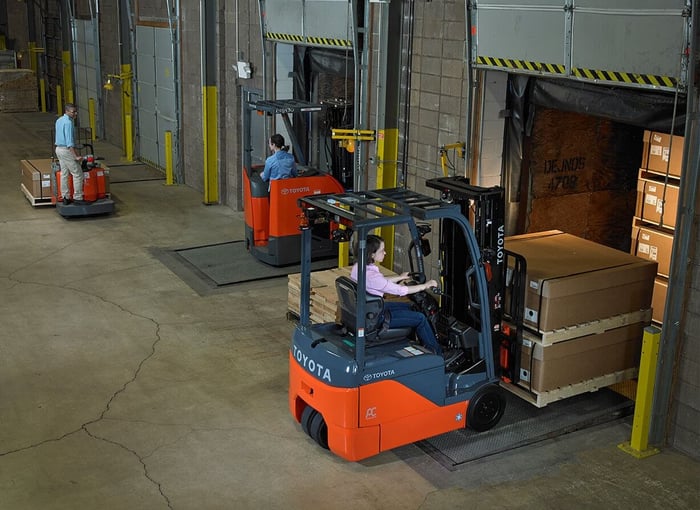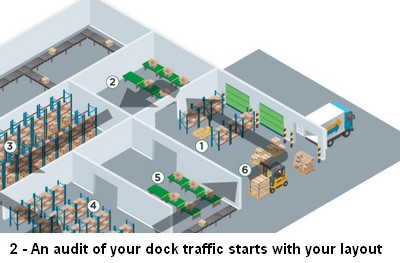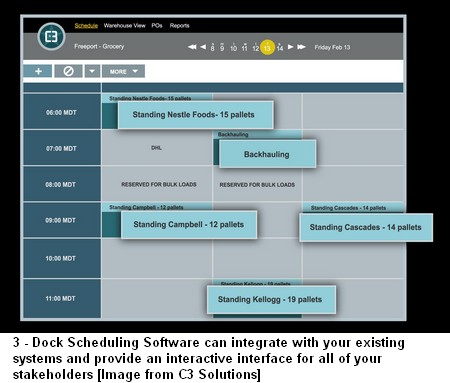
There is perhaps no more important part of your facility than your dock. It’s the start – and the end – of your day, your end-to-end process, and your accounting for your shipments! So making the processes that depend on your dock as smooth and efficient as possible gives everything in-between a better foundation for success.
The Grand Central Station of Your Facility
 The typical dock for businesses like retail distribution, E-commerce and other high-volume facilities can be a full-day, high-traffic tangle of incoming and outgoing pallets, boxes, trucks, forklifts, scanner-armed staff, telescoping conveyors, labels and potentially dozens of other types of equipment or moving objects. Though if you’re fortunate enough to have your receiving bays and shipping bays on opposite sides of the facility (or at least dedicated as one or the other), then maybe it’s not quite as chaotic as this may sound. But it can always be better, right?
The typical dock for businesses like retail distribution, E-commerce and other high-volume facilities can be a full-day, high-traffic tangle of incoming and outgoing pallets, boxes, trucks, forklifts, scanner-armed staff, telescoping conveyors, labels and potentially dozens of other types of equipment or moving objects. Though if you’re fortunate enough to have your receiving bays and shipping bays on opposite sides of the facility (or at least dedicated as one or the other), then maybe it’s not quite as chaotic as this may sound. But it can always be better, right?
Here are some typical issues that are common in most dock areas:
- Frequent wait times for trucks that result in detention fees.
- Incoming pallets get put away in the wrong place.
- Outgoing shipments are slow to load or get loaded from the wrong bay.
- The Receiving team receives loads at inefficient times resulting in overtime.
- Carriers refuse to pick-up because of long wait times.
- The warehouse doesn’t have prior knowledge of arrival times and dates of incoming shipments.
- CSRs, buyers and managers don’t have visibility into the status of incoming shipments, resulting in unnecessary communications with the warehouse.
While this is just a partial list of potential dock issues, the potential not only for massive waste and inefficiency is large. But even more importantly, the mistakes that could come from these issues could lead to lost sales and lost customers.
There are a lot of ways to approach a full “dock re-org” for your facility, but here are three solutions that we’ve found to help solve a big part of the problem.
Re-Evaluate Your Layout
One of the most practical places to start is with your layout. Changes here can be really simple and quick or very involved and complex. Here are the questions you should be asking yourself.
- Does the timing of outgoing and incoming shipments overlap?
- If they do, do you have separate bays for each process?
- Is the dock laid out to align with the closest relevant process area?

- Are the replenishment shelves and return areas closest to the receiving dock?
- Are you packing and shipping stations closest to the shipping dock?
The basic principle is to keep the traffic in any one area flowing in one direction. Keep the incoming on its own receiving dock and direct to its destination(s). Set up your packing area closer to the shipping dock. If you have shipments going out at the same time others are coming in, try to dedicate the bays closest to the relevant process area for one or the other. If you have a smaller dock and need to swap the bays for incoming (morning) and outgoing (evening), then make sure your equipment is mobile enough to keep the space flexible and clear as needed.
Deploy Dock Scheduling Software with Your WMS
When your dock is in high demand in these situations, it makes sense to think of it as a popular, limited quantity asset in the same manner as a restaurant, a dentist’s office or a salon. In other words, it should require an appointment! C3 Solutions, a provider of dock scheduling software, says you’ll be more successful if you can establish:

- Inbound and outbound appointment volumes.
- Percentage of live unloads versus dropped trailers in the yard.
- Percentage of collect versus prepaid shipments.
- Merchandising priorities (promotions, shortages, product types).
- Load types that your warehouse can or cannot receive during specific times of the day.
- Compliance issues.
- Labor constraints per shift.
- During certain shifts, is your unloading labor shared with other duties (warehousing)?
- Unloading issues related to palletized, floor loaded and slip sheets.
- Physical dock restrictions and equipment constraints per shift per site.
- A current number of standing appointments.
- Recurring appointments (these may be seasonal or punctual)
- The number of hours or days of the advanced notice required to plan effectively the traffic, respecting your other business constraints.
A good dock scheduling software product can integrate with your Warehouse Management System (WMS), Transportation Management System (TMS) or ERP. Taking a good inventory of the different events and transactions described in the list above can allow you to automate a lot of the scheduling and create an interactive portal where late arrivals, no-shows, etc. are tracked 24/7 and creates visibility to all of your managers.
Make Your Print Solution Mobile
Finally, one of the most common traffic issues from the dock is the foot traffic of the staff moving back and forth from the dock to the office to retrieve paperwork. “Paperwork” can include not only the manifests and other documents related to the incoming outgoing shipments, but the labels used for the incoming cases, shipping labels for packages, etc.
When you take your warehouse printers out on the floor, they can become a versatile tool that can eliminate extra traffic by doing your printing on demand where it’s needed when it’s needed. A mobile printer can move from bay-to-bay as shipments arrive, and by eliminating the time required to walk back and forth to a stationary printer, your facility can not only become more efficient but work with fewer printers in some cases.
Carts with batteries custom-built for powering printers are a small investment with a big return. As part of the bigger solution to managing your dock traffic, they provide a complete workstation right in the middle of the action that can not only be used by front-line staff to process receiving or shipping, but to serve as a tool for supervisors as well.
An Overlooked Part of the Facility
As part of optimizing the workflow in your warehouse, getting your dock organized and running smoothly is the most critical piece of the puzzle. Auditing your current shipping and receiving processes to provide the basis for rationalizing your layout, implementing dock scheduling software and reducing foot traffic with mobile workstations is the first step to creating a positive down process effect for the whole facility.